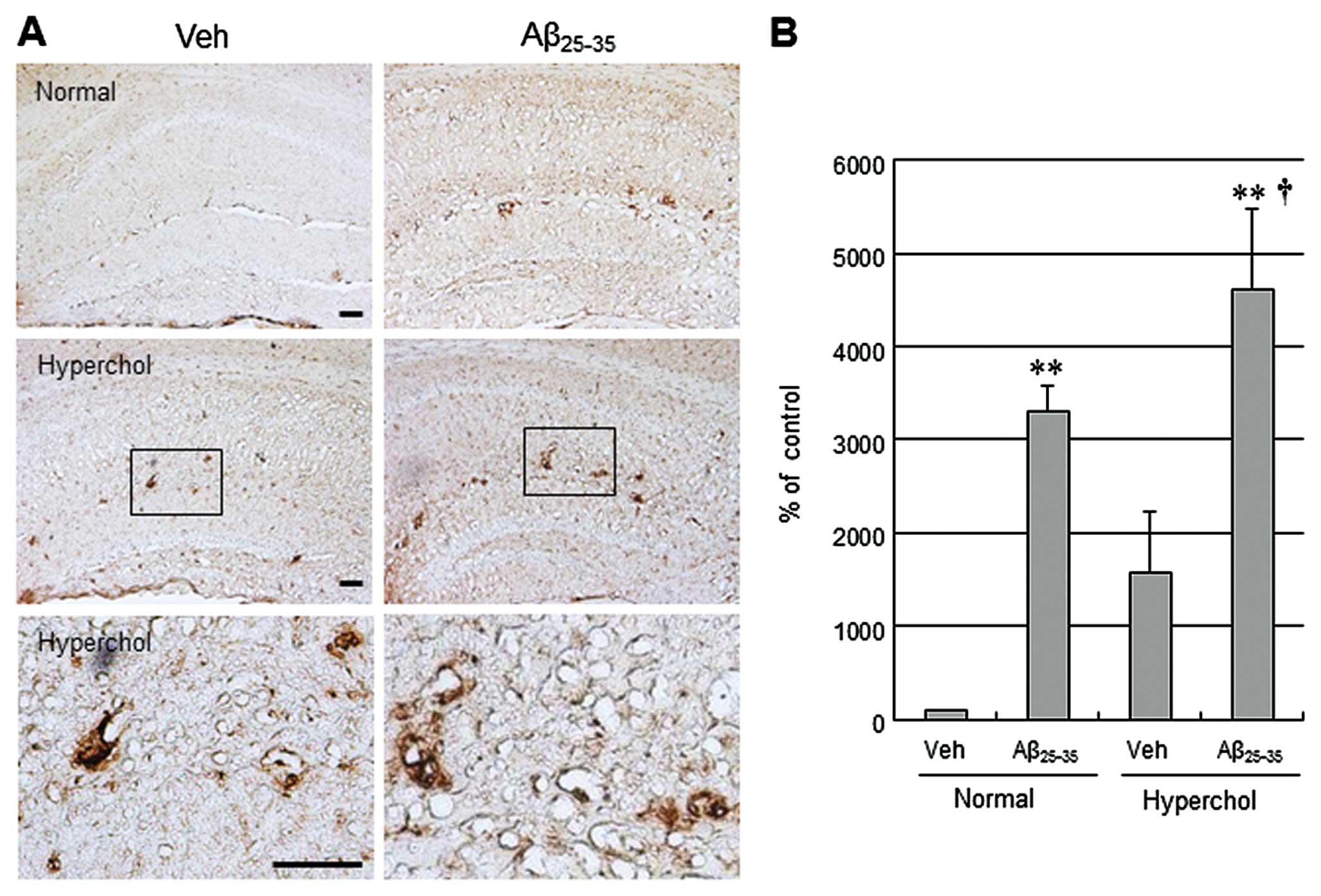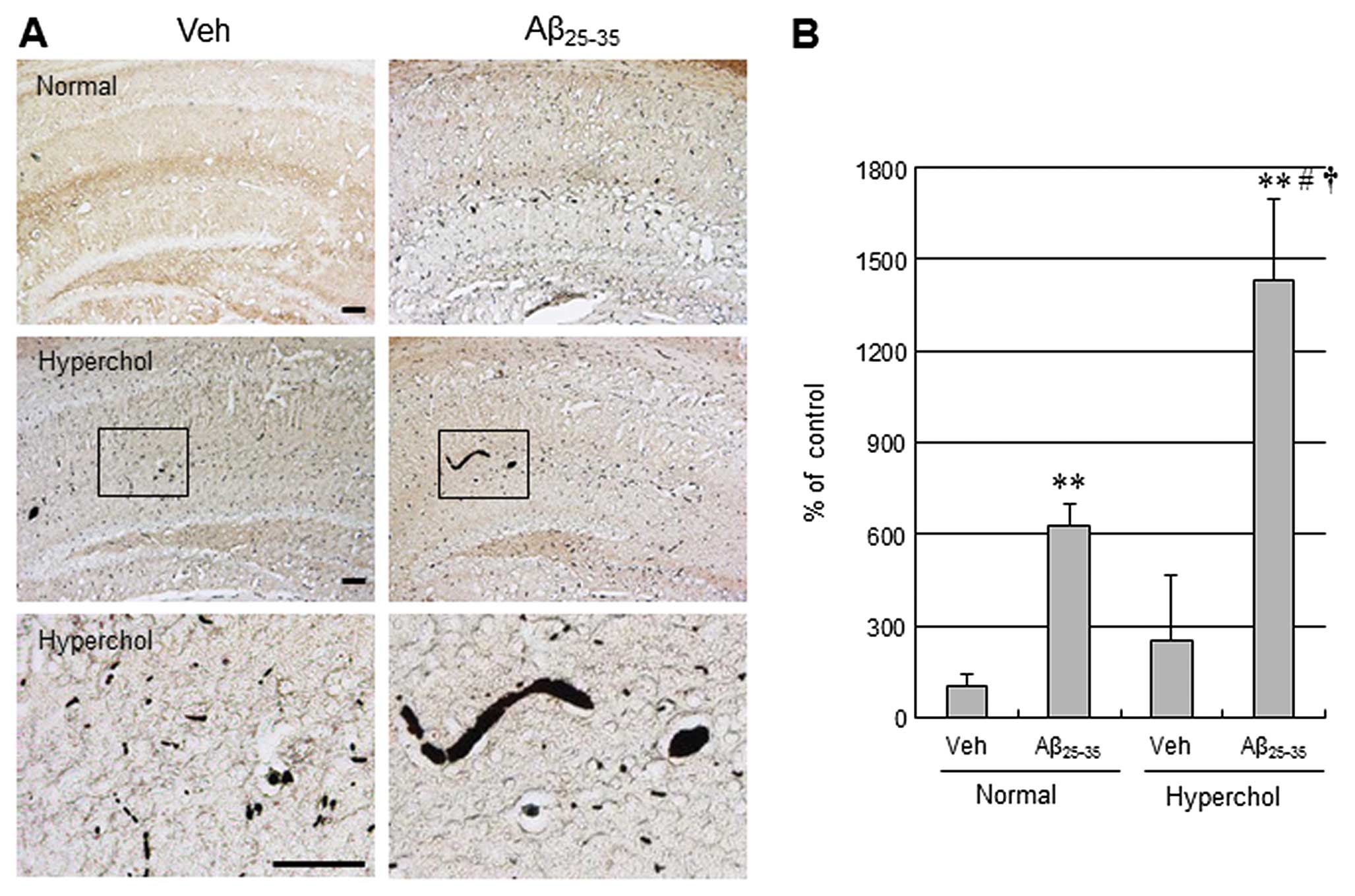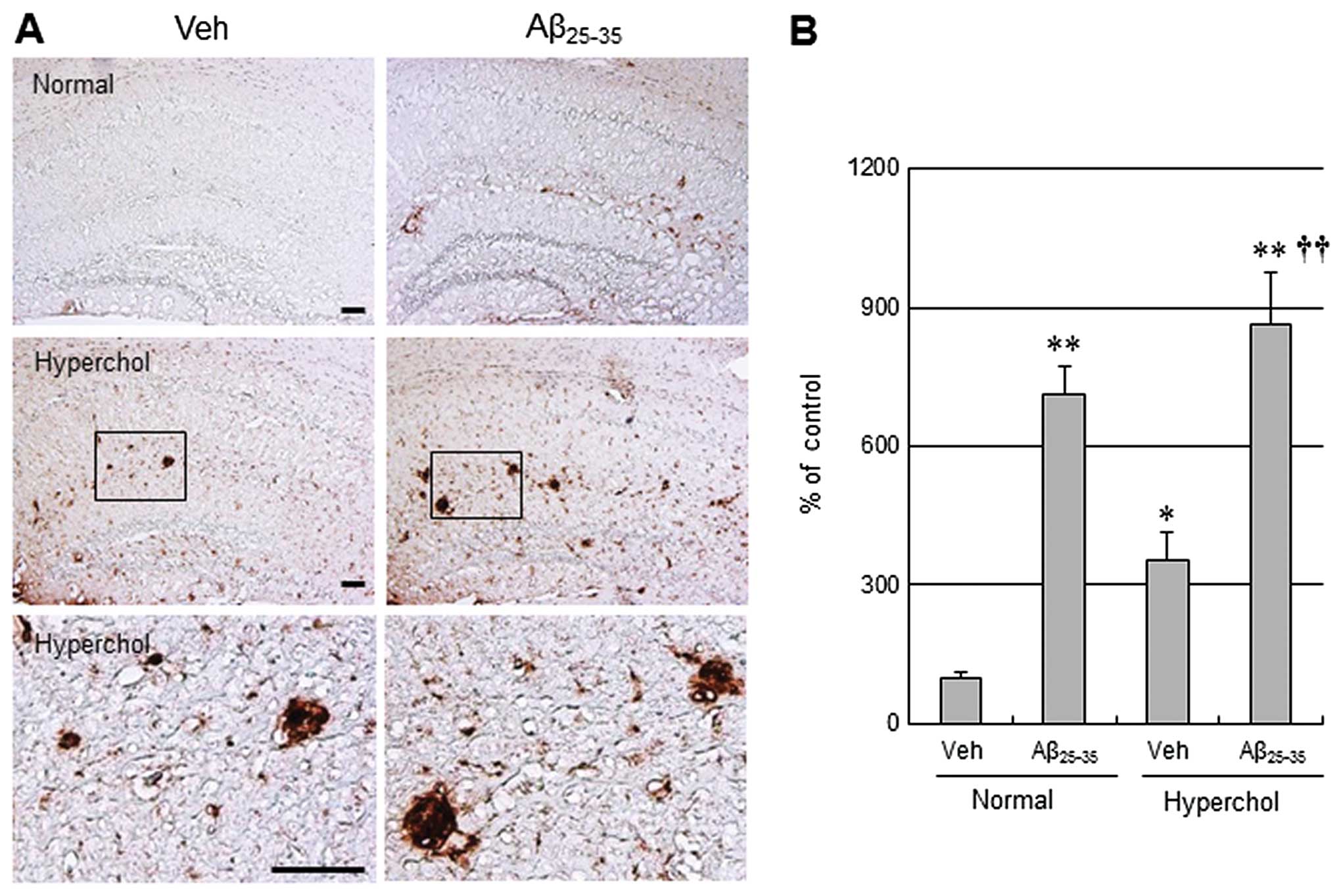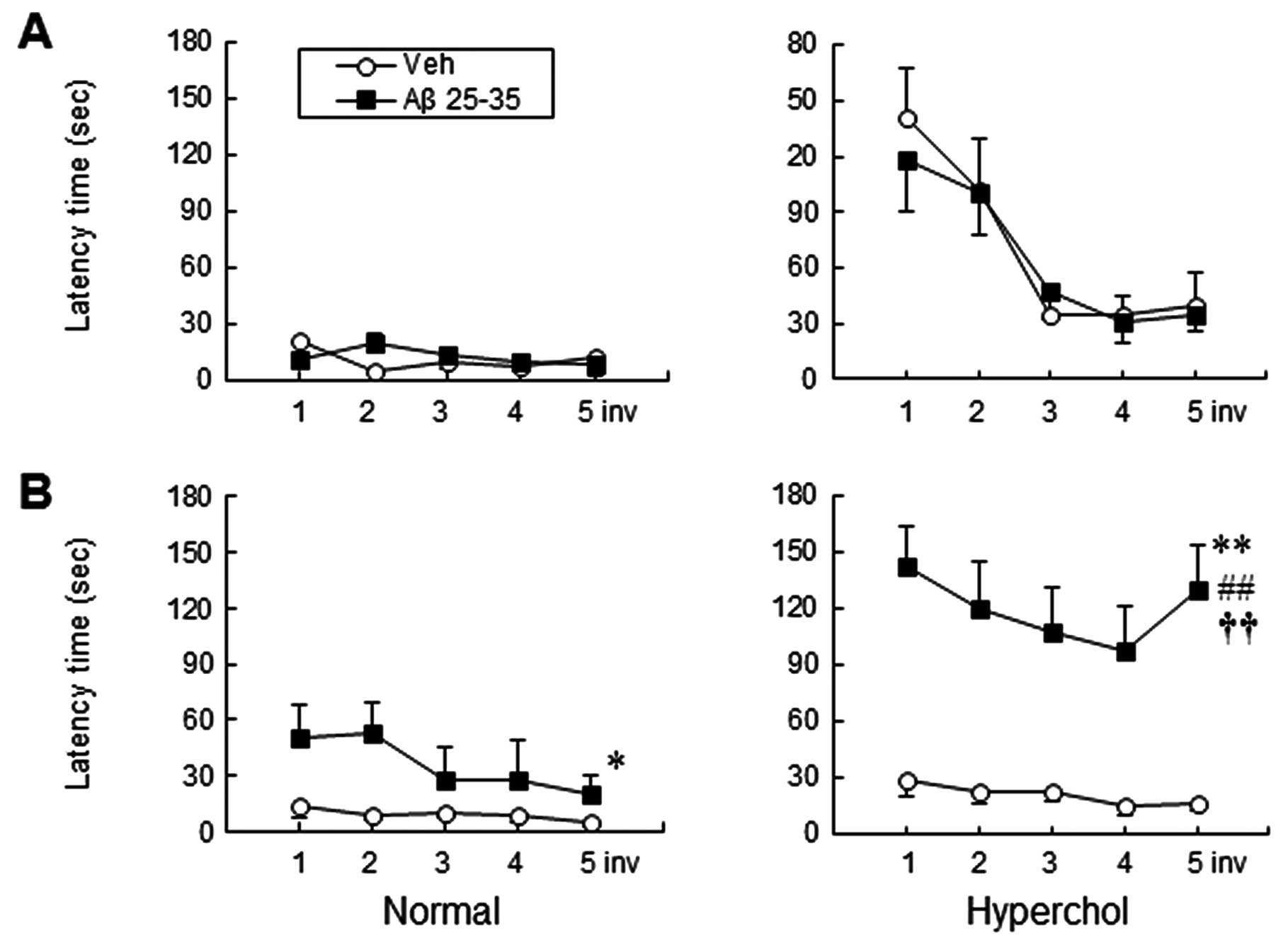Hypercholesterolemia accelerates amyloid β-induced cognitive deficits
- Authors:
- Published online on: January 8, 2013 https://doi.org/10.3892/ijmm.2013.1233
- Pages: 577-582
Abstract
Introduction
Alzheimer’s disease (AD) is characterized by cerebrovascular damage and neuronal dysfunction leading to progressive cognitive decline. The hallmark pathologies of AD include amyloid β-peptide (Aβ) deposition, neurofibrillary tangles containing hyperphosphorylated tau and increased microglial reactivity as well as inflammatory processes. Hypercholesterolemia, a well-established vascular risk factor, is associated with the pathophysiology of AD (1,2) and it has also been shown to increase the production of Aβ in animal and cellular models (3–7). However, the mechanism by which hypercholesterolemia causes Aβ accumulation in the brain and contributes to the pathogenesis of AD remains unclear.
Hypercholesterolemia and AD share inflammation as a pathophysiological trait. It was considered that high levels of serum cholesterol would induce vascular changes similar to early inflammatory lesions of atherosclerosis and blood brain barrier permeability as well as localized neuroinflammatory changes (8). Furthermore, chronic inflammatory responses including microglial activation have been detected in AD brains (9,10). It is likely that hypercholesterolemia resulting from either dietary practice or genetic disposition facilitates an exacerbated neuroinflammatory response in association with increased Aβ generation, leading to AD-associated degeneration. To test this theory, we administered a high-fat diet to a hypercholesterolemic strain (Apo E KO mice) for 4 weeks prior to Aβ25–35 injection and for 4 weeks following Aβ25–35 injection, for a total of 8 weeks of treatment. This was followed by assessment of cognitive function with respect to neuroinflammatory and AD-related biochemical changes.
We hypothesized that hypercholesterolemia accelerates amyloid pathology, tau pathology and neuroinflammation, subsequently exacerbating the cognitive decline in AD. We investigated the effects of hypercholesterolemia on AD-related neuropathological markers including Aβ, phosphorylatedtau (p-tau) and microglial activation in the brains of normal and hypercholesterolemic mice injected with Aβ25–35 (a toxic fragment of full-length Aβ). Spatial learning and memory in Aβ25–35-injected mice was assessed by the Morris water maze test. Exploring the interplay between hypercholesterolemia and AD may enable development of a rational basis for the prevention and treatment of AD underlying clinically detected dementia.
Materials and methods
Aβ25–35 injection model
Wild-type male C57BL/6J and apolipoprotein E knock out (Apo E KO) mice (Japan SLC, Shizuoka, Japan) were housed under diurnal lighting conditions and allowed food and tap water ad libitum. All animal procedures were conducted in accordance with the institutional guidelines for animal research, and approved by the University Animal Care and Use Committee (PNU-2011-000419). An Aβ-induced cognitive impairment mouse model was produced based on modification of previously reported methods (11). Anesthesia was achieved by isoflurane (2% induction and 1.5% maintenance, in 80% N2O and 20% O2) administered via a face mask. The depth of anesthesia was confirmed by the absence of cardiovascular changes in response to tail pinch. Rectal temperature was kept at 36.5–37.5°C using a Panlab™ thermostatically controlled heating mat (Harvard Apparatus, Holliston, MA, USA). Aβ25–35 (10 nmol in 5 μl of saline; Sigma-Aldrich, St. Louis, MO, USA) was injected intracerebroventricularly (icv) into the mice, aimed at 1 mm lateral to the midline, 0.5 mm posterior to the bregma and 3 mm deep using a 25 μl Hamilton syringe with a 26-gauge needle (Hamilton, Reno, NV, USA) at a rate of 0.5 μl/min using a stereotaxic injector (KD Scientific, Holliston, MA, USA). The vehicle group of mice received icv injections of an equal volume of saline. Hypercholesterolemia was induced by providing a Western-type high-fat diet (42% of total calories from fat; 0.15% cholesterol; Research Diets, New Brunswick, NJ, USA) for 4 weeks in Apo E KO mice prior to Aβ25–35 injection and for 4 weeks following Aβ25–35 injection, for a total of 8 weeks.
Measurement of plasma cholesterol
Blood was collected from the left ventricle under light anesthesia and stored on ice for 30 min prior to centrifugation at 13,000 rpm and 4°C for 10 min, after which the plasma was separated and kept at −80°C until assayed. The lipoprotein cholesterol distribution of plasma samples was determined enzymatically with reagents from Kyowa Medex (Tokyo, Japan) using a TBA-200FR NEO apparatus (Toshiba Medical Systems, Tokyo, Japan).
Immunohistochemistry
Four weeks after Aβ25–35 injection, mice were deeply anesthetized with thiopental sodium and subsequently perfused transcardially with cold PBS followed by 4% paraformaldehyde for fixation. The brain of each mouse was then removed and further fixed for 24 h in 4% paraformaldehyde at 4°C followed by cryoprotection in 20% sucrose for 72 h at 4°C. Next, the isolated brains were frozen in an optical cutting temperature medium for frozen tissue specimens (Sakura Finetek, Torrance, CA, USA) and then stored in the freezer at −80°C until examined. The frozen brains were subsequently cut at a thickness of 10 μm using a Leica CM 3050 Cryostat (Leica Microsystems, Wetzlar, Germany), after which the sections were immunostained with antibodies against Aβ (Covance, Emeryville, CA, USA), p-tau (Sigma-Aldrich) and CD11b (Serotec, Oxford, UK). Following additional incubation with biotinylated secondary antibody, samples were incubated in ABC reagent (Vector Laboratories, Burlingame, CA, USA). All reactions were visualized by development in 3,3′ diaminobenzidine substrates (Vector Laboratories), and all samples were visualized using a light microscope (Carl Zeiss, Jena, Germany). The immunoreaction products were quantified using the iSolution full image analysis software (Image & Microscope Technology, Vancouver, BC, Canada).
Morris water maze task
Spatial learning and memory deficits were assessed using the Morris water maze task as previously described (11) with minor modification. The experiment was performed on mice after a 1- or 4-week Aβ25–35 injection period. The maze consisted of a 1.15-m-diameter pool that was painted flat white and had a 10-cm-diameter platform halfway between the center of the pool and the edge, 1 cm below the surface of the water. The water in the pool was made opaque by the addition of powdered milk. The water temperature was 19–21°C. The water tank was located in a test room that contained several cues external to the maze. The position of the cues remained unchanged throughout the water-maze task. Each mouse was subjected to a series of 5 trials/day. For each trial, mice were randomized to 1 of 4 directional starting locations (north, south, east and west) and placed in the pool facing the wall. During the 4 subsequent training days, the mice were given 5 trial sessions/day with the platform in place before an Aβ25–35 injection. When a mouse located the platform, it was permitted to remain on it for 10 sec. If the mouse did not locate the platform within 180 sec, it was placed on the platform for 10 sec. Mice were given a maximum of 180 sec to find the submerged platform. Swimming was videotaped, and the escape latency time to reach the platform was analyzed using the Smart software (Panlab, Barcelona, Spain).
Data analysis
All data are expressed as the means ± SEM. Statistical comparisons were performed using paired or unpaired Student’s t-tests, and one-way analysis of variance (ANOVA) or two-way ANOVA for repeated measures followed by Fisher’s protected least significant difference test. P<0.05 was considered to indicate a statistically significant difference.
Results
Hypercholesterolemia increases Aβ, p-tau and CD11b expression in Aβ-injected mice
Plasma cholesterol levels were significantly higher in Apo E KO mice that were fed a high-fat diet than in control mice fed normal chow (737.56±27.58 vs. 99.4±7.58 mg/dl, respectively, P<0.01), indicating that administration of the high-fat diet for 8 weeks induced hypercholesterolemia. To validate the function of hypercholesterolemia on AD in vivo, Aβ25–35 was used for the AD-like pathological model in this study. Unilateral icv injection of Aβ25–35 led to increased immunoreactivity for the AD-related neuropathological markers Aβ and p-tau in the hippocampus (Figs. 1 and 2). Moreover, hypercholesterolemia tended to increase Aβ and p-tau levels in the vehicle group and further increased Aβ and p-tau levels in Aβ25–35-injected mice. CD11b (also known as αmβ2 integrin and Mac1) is a sensitive marker of microglial activation. Immunostaining of CD11b was evident in the hippocampus of normal mice receiving icv injections of Aβ25–35 (Fig. 3). Consistent with Aβ and p-tau, hypercholesterolemia led to a more significant increase in CD11b immunostaining in both the vehicle group and the Aβ25–35-injected group of hypercholesterolemic mice. However, there were no significant changes in GFAP immunoreactivity in normal and hypercholesterolemic mice treated following Aβ25–35 icv injections (data not shown).
Hypercholesterolemia aggravates cognitive impairment in Aβ-injected mice
To verify whether hypercholesterolemia has any effect on cognitive deficits, we subjected the mice to a water maze. As shown in Fig. 4, icv injection of Aβ25–35 resulted in a significantly increased escape latency time in the target quadrant when compared to the vehicle group at 4 weeks after Aβ injection (P<0.05 vs. vehicle) (Fig. 4B). Conversely, no significant difference was observed among groups at 1 week after Aβ injection (Fig. 4A). Moreover, hypercholesterolemia significantly exacerbated the cognitive decline when compared to the Aβ25–35-injected group of normal mice at 4 weeks after Aβ injection (P<0.01, two-way ANOVA for repeated measures). Thus, decreased spatial learning in response to hypercholesterolemia was coincident with accelerated expression of Aβ and p-tau and activation of microglia in the Aβ25–35-injected group of hypercholesterolemic mice.
Discussion
In the present study, we examined the effects of hypercholesterolemia on the cognitive deficits in Aβ25–35-injected mice with respect to neuroinflammatory and AD-related biochemical changes. Our results demonstrated that hyper-cholesterolemia strongly accelerated Aβ accumulation, p-tau expression and microglial activation in the brains of Aβ25–35-injected mice. In addition, hypercholesterolemia significantly aggravated spatial learning and memory in Aβ25–35-injected mice as assessed by the Morris water maze test. These data suggest that hypercholesterolemia accelerates the AD-related pathology, which was accompanied by neuroinflammation and subsequent memory impairment in this mouse model. Thus, we propose that diet can be used to modulate the risk of developing AD.
Clinical studies indicate that patients with elevated cholesterol have increased susceptibility to AD (12–14) and that lowering plasma cholesterol with statin therapy during middle age is likely to benefit cognitive function in later life (15,16). Experimental studies using rabbits (3) and a transgenic mouse model of AD (4–6) have demonstrated that diet-induced hypercholesterolemia increased Aβ levels in the brain and thus accelerated extracellular Aβ deposition. Aβ depositions and neurofibrillary tangles are distinctive hallmarks of AD. A disturbed cholesterol homeostasis within lipid rafts might influence amyloid precursor protein (APP) processing, which results in increased Aβ production and deposition (17,18). Conversely, little is known about the function of cholesterol in the formation of neurofibrillary tangles. Our data revealed that hypercholesterolemia enhanced Aβ as well as p-tau levels in the brain, which was confirmed by descriptive immunohistochemical analysis. Our findings are in accordance with previous studies showing elevated concentrations of Aβ (4,19,20) and an enhanced level of hyperphosphorylated tau (20) after consumption of a cholesterol-enhanced diet.
AD is characterized by cerebrovascular damage and neuronal dysfunction, which leads to progressive cognitive decline. Despite clear evidence of hypercholesterolemia-induced amyloid pathology, the relationship between hypercholesterolemia and memory impairment in animals is somewhat controversial (21–23). In this study, hypercholesterolemia led to significant exacerbation of cognitive decline when compared to the Aβ25–35-injected group of normal mice at 4 weeks after Aβ injection. Similar to our findings, aggravation of learning deficits in association with Aβ deposition in APP transgenic mice with low density lipoprotein receptor (LDLR)-deficiency has been reported (24).
The exact mechanisms responsible for the cognitive deficit induced by hypercholesterolemia in mice remain unknown. One possible explanation is that a oxidative-inflammatory cycle in the vasculature could have deleterious consequences for brain function and cognition (25,26). It is well known that inflammation occurs in AD brains and hypercholesterolemic animal models (8,26). Our data demonstrate that hypercholesterolemia induced elevated immunohistochemical-positive staining for the microglial marker CD11b. There is now convincing evidence that inflammatory cascades primarily mediated by activated microglia play a significant role in AD-like changes (9,27). The mechanism of microglial activation and the role of hypercholesterolemia in the process of neuroinflammation are not fully known. It is possible that the systemic inflammation under hypercholesterolemic conditions, which causes dysfunctional cerebrovasculature, may trigger activation of the perivascular microglia (28) and recruitment of microglia to the inflamed brain arterioles could then initiate a cascade of events leading to AD-like pathology and cognitive dysfunction.
The effects of hypercholesterolemia in vivo have been studied in different animal models, and experimental studies have shown that hypercholesterolemia increases brain Aβ deposition and neuroinflammation in rabbits (3), soluble APP transgenic mice (4) and LDLR deficit mice (26). In the present study, we used Apo E KO mice on a high-fat diet to induce hypercholesterolemia and Aβ25–35, a toxic core fragment of full-length Aβ1–40 (29), to model AD-like pathology. Although it remains unclear whether the Aβ25–35 fragment occurs in AD brains, a number of studies have demonstrated that the acute injection of this peptide into the cerebral ventricle results in some pathological events observed in AD, such as neurotoxic effects similar to those produced by Aβ1–40 (30) or impairment of memory in mice (31). To the best of our knowledge, the present study is the first to examine the hypercholesterolemic effects in an Aβ25–35-injected AD-like pathological mouse model.
In conclusion, the present study supports the findings of clinical studies suggesting that a high-fat diet increases the risk of developing AD and therefore suggests that diet could be used to reduce the risk of developing the disease. These findings suggest that dietary methods might offer a path to the prevention of AD without resorting to drugs that are expensive and may have harmful side-effects.
Acknowledgements
This work was supported by a 2-Year Research Grant of Pusan National University.
References
|
Solomon A and Kivipelto M: Cholesterol-modifying strategies for Alzheimer’s disease. Expert Rev Neurother. 9:695–709. 2009.PubMed/NCBI | |
|
Stefani M and Liguri G: Cholesterol in Alzheimer’s disease: unresolved questions. Curr Alzheimer Res. 6:15–29. 2009. | |
|
Sparks DL, Scheff SW, Hunsaker JC III, Liu H, Landers T and Gross DR: Induction of Alzheimer-like beta-amyloid immuno-reactivity in the brains of rabbits with dietary cholesterol. Exp Neurol. 126:88–94. 1994. View Article : Google Scholar : PubMed/NCBI | |
|
Refolo LM, Malester B, LaFrancois J, et al: Hypercholesterolemia accelerates the Alzheimer’s amyloid pathology in a transgenic mouse model. Neurobiol Dis. 7:321–331. 2000. | |
|
Levin-Allerhand JA, Lominska CE and Smith JD: Increased amyloid- levels in APPSWE transgenic mice treated chronically with a physiological high-fat high-cholesterol diet. J Nutr Health Aging. 6:315–319. 2002.PubMed/NCBI | |
|
Shie FS, Jin LW, Cook DG, Leverenz JB and LeBoeuf RC: Diet-induced hypercholesterolemia enhances brain A beta accumulation in transgenic mice. Neuroreport. 13:455–459. 2002. View Article : Google Scholar : PubMed/NCBI | |
|
Simons M, Keller P, De Strooper B, Beyreuther K, Dotti CG and Simons K: Cholesterol depletion inhibits the generation of beta-amyloid in hippocampal neurons. Proc Natl Acad Sci USA. 95:6460–6464. 1998. View Article : Google Scholar : PubMed/NCBI | |
|
Xue QS, Sparks DL and Streit WJ: Microglial activation in the hippocampus of hypercholesterolemic rabbits occurs independent of increased amyloid production. J Neuroinflammation. 4:202007. View Article : Google Scholar : PubMed/NCBI | |
|
Akiyama H, Barger S, Barnum S, et al: Inflammation and Alzheimer’s disease. Neurobiol Aging. 21:383–421. 2000. | |
|
Rogers J: The inflammatory response in Alzheimer’s disease. J Periodontol. 79(Suppl 8): S1535–S1543. 2008. | |
|
Takeda S, Sato N, Niisato K, et al: Validation of Abeta1-40 administration into mouse cerebroventricles as an animal model for Alzheimer disease. Brain Res. 1280:137–147. 2009. View Article : Google Scholar : PubMed/NCBI | |
|
Casserly I and Topol E: Convergence of atherosclerosis and Alzheimer’s disease: inflammation, cholesterol, and misfolded proteins. Lancet. 363:1139–1146. 2004. | |
|
Sjogren M, Mielke M, Gustafson D, Zandi P and Skoog I: Cholesterol and Alzheimer’s disease - is there a relation? Mech Ageing Dev. 127:138–147. 2006. | |
|
Canevari L and Clark JB: Alzheimer’s disease and cholesterol: the fat connection. Neurochem Res. 32:739–750. 2007. | |
|
van Vliet P, van de Water W, de Craen AJ and Westendorp RG: The influence of age on the association between cholesterol and cognitive function. Exp Gerontol. 44:112–122. 2009. | |
|
Cedazo-Minguez A, Ismail MA and Mateos L: Plasma cholesterol and risk for late-onset Alzheimer’s disease. Expert Rev Neurother. 11:495–498. 2011. | |
|
Ghribi O: Potential mechanisms linking cholesterol to Alzheimer’s disease-like pathology in rabbit brain, hippocampal organotypic slices, and skeletal muscle. J Alzheimers Dis. 15:673–684. 2008. | |
|
Simons M, Keller P, Dichgans J and Schulz JB: Cholesterol and Alzheimer’s disease: is there a link? Neurology. 57:1089–1093. 2001. | |
|
Sharma S, Prasanthi RPJ, Schommer E, Feist G and Ghribi O: Hypercholesterolemia-induced Abeta accumulation in rabbit brain is associated with alteration in IGF-1 signaling. Neurobiol Dis. 32:426–432. 2008. View Article : Google Scholar : PubMed/NCBI | |
|
Ghribi O, Larsen B, Schrag M and Herman MM: High cholesterol content in neurons increases BACE, beta-amyloid, and phosphorylated tau levels in rabbit hippocampus. Exp Neurol. 200:460–467. 2006. View Article : Google Scholar : PubMed/NCBI | |
|
Fitz NF, Cronican A, Pham T, et al: Liver X receptor agonist treatment ameliorates amyloid pathology and memory deficits caused by high-fat diet in APP23 mice. J Neurosci. 30:6862–6872. 2010. View Article : Google Scholar : PubMed/NCBI | |
|
Ullrich C, Pirchl M and Humpel C: Hypercholesterolemia in rats impairs the cholinergic system and leads to memory deficits. Mol Cell Neurosci. 45:408–417. 2010. View Article : Google Scholar : PubMed/NCBI | |
|
Schreurs BG: The effects of cholesterol on learning and memory. Neurosci Biobehav Rev. 34:1366–1379. 2010. View Article : Google Scholar : PubMed/NCBI | |
|
Cao D, Fukuchi K, Wan H, Kim H and Li L: Lack of LDL receptor aggravates learning deficits and amyloid deposits in Alzheimer transgenic mice. Neurobiol Aging. 27:1632–1643. 2006. View Article : Google Scholar : PubMed/NCBI | |
|
Evola M, Hall A, Wall T, Young A and Grammas P: Oxidative stress impairs learning and memory in apoE knockout mice. Pharmacol Biochem Behav. 96:181–186. 2010. View Article : Google Scholar : PubMed/NCBI | |
|
Thirumangalakudi L, Prakasam A, Zhang R, et al: High cholesterol-induced neuroinflammation and amyloid precursor protein processing correlate with loss of working memory in mice. J Neurochem. 106:475–485. 2008. View Article : Google Scholar : PubMed/NCBI | |
|
Heneka MT and O’Banion MK: Inflammatory processes in Alzheimer’s disease. J Neuroimmunol. 184:69–91. 2007. | |
|
Perry VH, Newman TA and Cunningham C: The impact of systemic infection on the progression of neurodegenerative disease. Nat Rev Neurosci. 4:103–112. 2003. View Article : Google Scholar : PubMed/NCBI | |
|
Yankner BA, Duffy LK and Kirschner DA: Neurotrophic and neurotoxic effects of amyloid beta protein: reversal by tachykinin neuropeptides. Science. 250:279–282. 1990. View Article : Google Scholar : PubMed/NCBI | |
|
Yamada K and Nabeshima T: Animal models of Alzheimer’s disease and evaluation of anti-dementia drugs. Pharmacol Ther. 88:93–113. 2000. | |
|
Kim DH, Kim S, Jeon SJ, et al: The effects of acute and repeated oroxylin A treatments on Abeta(25–35)-induced memory impairment in mice. Neuropharmacology. 55:639–647. 2008.PubMed/NCBI |













